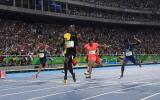Folders |
How Japan Broke the Form Chart in Olympic 4x100 Relay FinalPublished by
How Japan Used Baton Exchanges to Win Relay Silver in RioBy Adam Kopet, DyeStat Editor One of the hardest aspects of the 4x100-meter relay is getting the baton around cleanly. It is something many countries, including the United States, have struggled with in the past 15 years. Jamaica, the world's best team for the past nine years, still has not shown the consistency that Japan has. Since 2001, Japan has placed in 10 out of 12 global finals. During that time, Japan has deviated from standard technique employed by the high powered teams. With no runners who have broken 10 seconds in the 100-meter dash, the team uses the underhand exchange, a more efficient technique, to make up for their lack of overall speed. That change has led to fourth-place finishes in the 2004 Athens and 2012 London Olympics and a bronze medal in the 2008 Beijing Olympics. However, even greater efforts have been put into perfecting the Japanese relay since 2014. Speaking to Spikes, Shunji Karube, the director of sprints at the Japanese national federation (JAAF), explained how the emphasis is now placed on a beautiful baton exchange. Using meticulous biomechanical data, each hand-off was perfected. Rio was the first time it all came together for the Japanese team. After losing the Asian record to China at the 2015 IAAF World Championships, the goal coming into the season was a sub 38-second clocking. The quartet of Ryota Yamagata, Shota Iizuka, Yoshihide Kiryu and Aska Cambridge did just that in the Olympic prelims, running 37.68. After making one final tweak, moving position markers for the outgoing runners by seven centimeters, Japan clocked a 37.60 and earned the silver medal, its best finish ever. Japan's 2016 success started all the way back in March with the first of several relay training camps. Not knowing who would make the team, every invited athlete needed to be fully prepared to step onto the track. By the time the official team was named in July, the adjustment was relatively simple. Now, looking ahead, Karube is still exploring ways to improve his relay squad. There are still a few technical adjustments to make, but the biggest boon to the team would be the addition of sub 10-second runners. For that, there is still some time, but the countdown to the 2020 Tokyo Olympics has already begun. |








